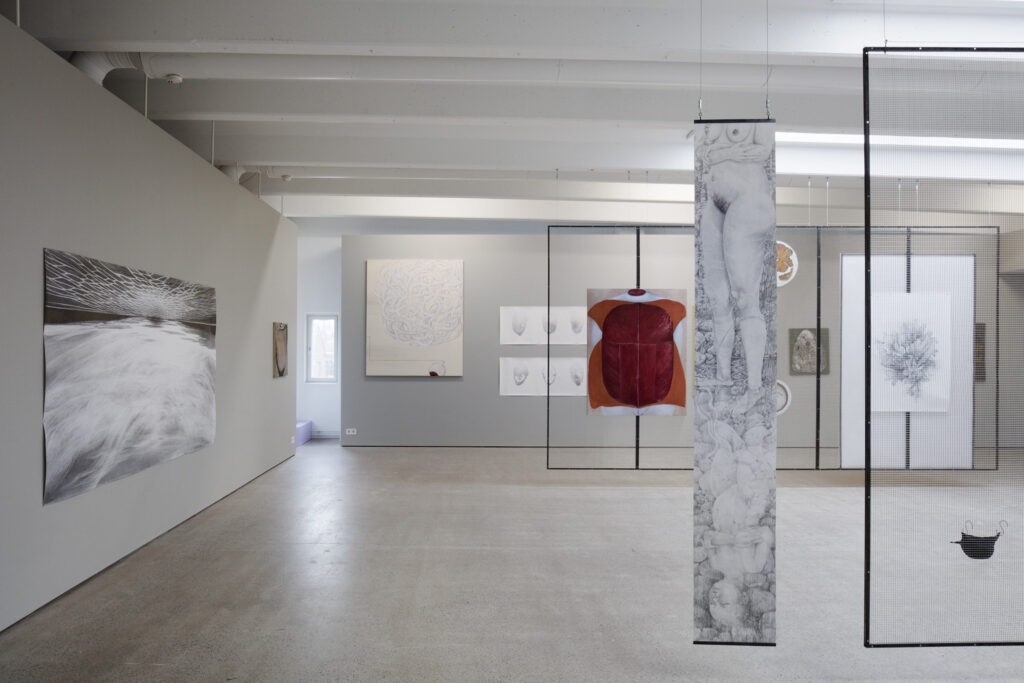This time the setup is different. The two Finnish artists Magdalena Åberg (1972) and Anna Tahkola (1983) have decided for a joint exhibition that allows them not only to display their works together, in a layered spatial arrangement, but also to juxtapose shared ideas and convictions and, inversely, to stress what makes their practices divergent and distinct.
The exhibition title ‘among, within’ evokes the commitment to figuration that is fundamental to both Åberg and Tahkola. They work mostly with representations of the human body, whether as visible societal presence (bodies among bodies) or as revealed inner reality (bodies within bodies). They both subscribe to the ethos of critical subjectivity, manifesting itself as visual and textual self-expression and allowing, above all, for nuanced personal reflection on contemporary life. They are nonetheless highly aware of gendered perception and the importance of countering explicit and implicit bias towards female concerns and narratives in art.
Magdalena Åberg shows previously unexhibited work belonging to several recent series or cycles. Her prime medium is oil on wood, but her contribution to ‘among, within’ also includes glazed ceramic pieces (the series Vessels, 2019–20) which, like the paintings, become variations on how the shapes and functions of human organs have been visualised in different ages and cultures. For some years, she has been rearticulating the visual history of Western medicine as painterly meditations on the organic, health and disease.
The earliest series of paintings in this exhibition date from 2018–19 and depict different aspects of human bodily interiority as seen through the eyes of illustrators from previous centuries, mostly from nineteenth-century medical manuals. They show non-descript slabs of organs ‘afflicted’ by colour (Matter), tissue viewed through early microscopes (Magnificence) or darkened stomachs or bladders, whole or dissected (Entrails). Other series incorporate more recent evidence of medical knowledge, such as scans of brains gradually hollowed out by Alzheimer’s disease (Memory Disease).
Åberg’s practice privileges visual temperature and texture over informational content and context. Indeed she strives to bring out the poetic within the scientific, the irrational within the rational. Her most recent paintings, presented under the collective title Within (2020–21), probe a more abstract direction for this overarching theme by loosely referencing plates by master woodcutter Aoki Shukuya for the medical treatise Kaishi Hen (The Analysis of Cadavers) published in Kyoto in 1772.
Anna Tahkola, whose dominant mode of articulation is pencil on large-format paper, has also executed There’s Something in the Air (2021), an on-site wall painting based on flowing distortions of organic form (and on the colours of the sand in Kohta’s concrete floors). This piece relates to her ongoing concern for the fluidity of shape and thought, in part inspired by Italian philosopher Emanuele Coccia and his insistence that ‘life has never left the fluid state’.
In her drawings from the last decade as well as in her most recent body of work, the two categories of work represented in ‘among, within’, Tahkola shows us different ways to interpret such fluidity. At times she conveys the sensuous physicality of a water surface, as in Heaven, Heaven, Heaven (2013) with its floating male nude. More often she focuses her own attention, and ours, on the reflections of nude female bathers in the water mirror offered by a pond or lake, in which ‘distortions’ are treated as the real thing without usurping the reality-effect created by graphite representation of bodies.
Recent examples include the pointedly corporeal women featured in My Brilliant Friends (2020), Endeavour (2021) and the narrow recto-verso composition Continuum (2021). The latter also sets up dialogues between maturity and infancy, waking and dreaming, bodies and faces, stones and plants.
Yet water isn’t Tahkola’s only fluid subject-matter. A theme that permeates her oeuvre is the porousness of any drawn boundary between the human figure and the natural world. It drives the ambiguity of the humanoid mask-like shapes in Transsubjectivity (2014) and of the vegetal variations in Polymorpha (2021).
Gallery name: Kohta
Address: Työpajankatu 2 B, building 7, 3rd floor, Helsinki
Opening hours: Wed-Fri 12:00 - 18:00, Sat-Sun 12:00 - 16:00
Open: 25.03.2021 - 20.06.2021







